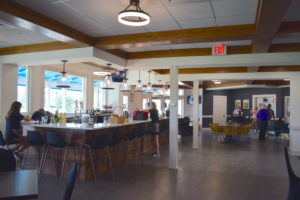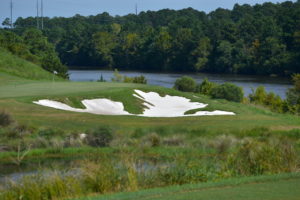6 Things You’ll Love About the Newly Renovated Resort Course at Grande Dunes
PlayGolfMyrtleBeach.com’s Charlie Rymer took part in the Resort Course at Grande Dunes’ grand re-opening last week, and got to experience first-hand the benefits of its many updated features. He found six aspects of the renovation especially compelling – and thinks you will, too!
By Charlie Rymer
On September 15th I had a chance to be one of the first golfers to play the newly renovated Grande Dunes Resort Course. The weather was perfect, and so is the renovation! One of the members of my group was golf course architect John Harvey, who was part of the original Resort Course design and construction team with Roger Rulewich. It’s always neat to get an inside view from the man charged with the work.
 The main scope of the project was greens restoration and greens renovation. But the entire facility got a freshening up, and that’s very evident when you walk in the clubhouse. The pro shop is brand new and the food and beverage operation is upgraded and has a great new vibe. Make sure you give their flatbreads a try!
The main scope of the project was greens restoration and greens renovation. But the entire facility got a freshening up, and that’s very evident when you walk in the clubhouse. The pro shop is brand new and the food and beverage operation is upgraded and has a great new vibe. Make sure you give their flatbreads a try!
Most golfers don’t realize that a golf course is a living, breathing organism that is constantly growing and deteriorating. It requires TLC, just like a beloved car or truck. At 100,000 miles you have to change the belts and hoses. But with a golf course you aren’t servicing the rear differential; you are restoring greens that have lost square footage, or bunkers that aren’t draining properly.
Have you ever played a bermudagrass golf course and noticed that the edges of the greens are uncomfortably distant from the edges of the greenside bunkers? Well, it didn’t start out like that. The green surface was originally much closer to the bunker edge. Over the years the grass around the green gradually took over the putting surface. In 30 years, a green can lose 20 to 30 percent of its putting surface through this encroachment, and this impacts the character and design of the course.
 That’s exactly what happened at Grande Dunes, and it’s wonderful to see ownership invest in the restoration. Along with their greens being restored to their original size, the greens have been updated with the latest in turf – in this case, the new turf is TifEagle. It’s an ultradwarf bermudagrass known for being smooth, fast, and resistant to establishing heavy grain or mutations.
That’s exactly what happened at Grande Dunes, and it’s wonderful to see ownership invest in the restoration. Along with their greens being restored to their original size, the greens have been updated with the latest in turf – in this case, the new turf is TifEagle. It’s an ultradwarf bermudagrass known for being smooth, fast, and resistant to establishing heavy grain or mutations.
John Harvey also used a new variety of bermudagrass called Northbridge as a buffer around the greens. This grass is not laterally aggressive, and will help protect the new greens from encroachment so the restored greens stay restored for as long as possible.
Renovation of bunkers is much more detailed than simply throwing new white sand on top of the old sand that has gone native. That old sand must be removed, and drainage in the bottom of the bunkers restored. In the case of Grande Dunes, John Harvey has done his magic by giving the bunker faces an uneven and lacy look. Great care goes into the shape and size of each bunker on the course.
There is often pressure to downsize bunkers during a course renovation, in order to hit budgets for both construction and maintenance moving forward. But the Resort Course at Grande Dunes is a BIG ballpark. If the bunkers were reduced in size, the scale would not be correct and the course just wouldn’t “feel” right. So they kept the bunkers BIG and BEAUTIFUL – and believe me, the investment paid off!
The end result is a golf course on a big piece of property with property lines and housing way outside of play, large greens with tons of character and hole locations, interesting bunkers that are appealing to the eye with appropriate size and scale, and an overall feel of a refreshed golf operation that was thoughtfully renovated. The Resort Course at Grande Dunes has great scenery, is fun to play if you choose the appropriate tees, and will be in excellent condition for years to come.
Because of its width, the Resort Course is also suitable for the average golfer or even beginners. But make no mistake: from the back tees, this course can challenge the best in the world. Check it out. You’ll be glad you did!



